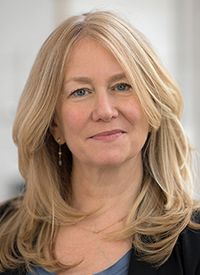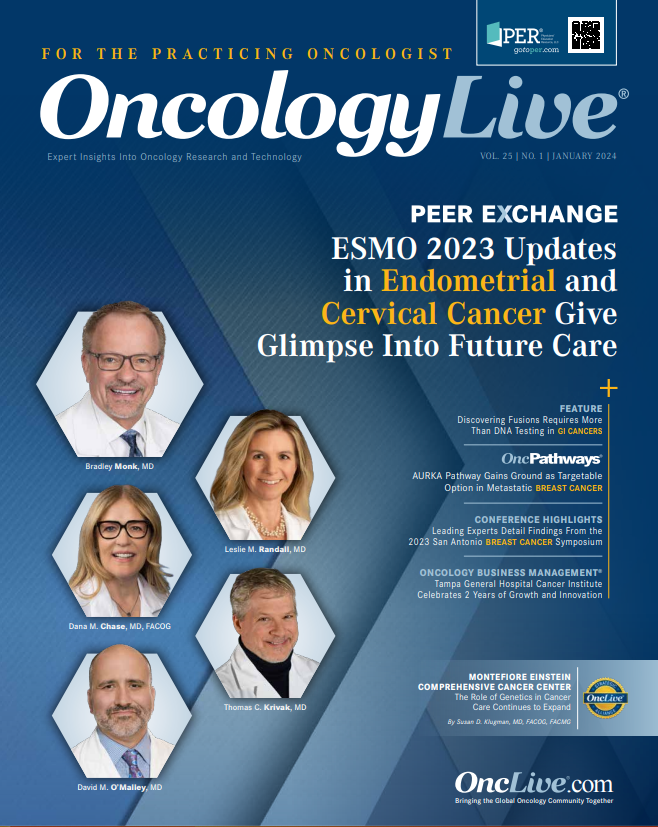The Role of Genetics in Cancer Care Continues to Expand
Genetic screening and testing have only recently become an integral part of cancer care.
Susan D. Klugman, MD, FACOG, FACMG

Genetic screening and testing have been a part of clinical practice for decades. However, it is only recently that genetics has become an integral part of cancer care.
The BRCA1/2 genes were discovered in 1994 and 1995, respectively, and many other cancer predisposition genes have been identified in more recent years. People with BRCA1/2 mutations are considered to have the most common hereditary cancer syndrome, called hereditary breast and ovarian cancer syndrome (HBOC).1 The National Comprehensive Cancer Network (NCCN) provides detailed recommendations regarding cancer surveillance and risk reduction for patients with HBOC. The impact on clinical care and management was initially unknown, but research and ongoing studies have provided guidance and NCCN guidelines are updated annually.2
Up to 10% of cancers arise in those who carry an inherited gene mutation.3 This is particularly important for Black patients, as research at our Montefiore Einstein Comprehensive Cancer Center found that not only are Black patients more likely than White patients to have a specific type of colorectal cancer that has worse outcomes, but they are also more likely to have tumors with more genetic mutations that preclude them from receiving certain therapies.4
In the 1970s, Montefiore Einstein was one of the first academic medical centers to offer population carrier screening for Tay-Sachs disease, an autosomal recessive neurologic genetic disorder that results in death in early childhood.5 In the late 1990s, we participated in the first BRCA1 and BRCA2 genetic testing of more than 1000 Ashkenazi Jewish women in the New York area, which led to a pivotal paper by Mary-Claire King, PhD, published in Science in 2003.6
Lifetime risk of breast cancer among female mutation carriers was 82%, and lifetime risk of ovarian cancer was 54% for BRCA1 and 23% for BRCA2 mutation carriers. Additionally, risk appeared to increase with time: Breast cancer risk by age 50 was 24% among mutation carriers born before 1940 and was 67% among women born after 1940. This was one of the first studies to show physical exercise and lack of obesity in adolescence was associated with delayed breast cancer onset.6
As the inheritance of most cancer predisposition genes is autosomal dominant, population screening is challenging and guidelines have evolved. Additionally, there are ethical, legal, and social implications of genetic testing, especially in diverse populations.
A Chance Meeting
In 1987, during my gynecologic oncology rotation as a fourth-year medical student, I participated in the care of a 65-year-old woman with ovarian cancer. Fast forward 12 years, I am a practicing obstetrician- gynecologist and I see a patient who tells me her mother was diagnosed in 1987 with ovarian cancer and had surgery at the same hospital, and during the same month that I did my acting internship. We were able to ascertain that I took care of her mother in 1987!
We then discussed the importance of BRCA1/2 testing, which was not available to her mother at the time. Today, it is standard of care to test for hereditary cancer syndromes for any patient with a first- or second-degree relative with ovarian cancer. My patient, in fact, did have a mutation or pathogenic variant in BRCA1, likely inherited from her mother.
Over the past 20-plus years, my patient has had a bilateral mastectomy with reconstruction, a bilateral salpingo-oophorectomy, and has been involved in research looking for predisposition to pancreatic cancer. She has had annual dermatologic and ophthalmologic examinations and has never had cancer. She is considered a previvor, a patient with a pathogenic variant who has never had cancer. We have reviewed and discussed the research and the clinical management of BRCA over the past 2 decades together. We have also discussed the options of in vitro fertilization and preimplantation genetic testing of embryos for her children, which would avoid hereditary cancer caused by the familial variant in future generations. This patient has also been instrumental as a resource for other previvors in their decision-making regarding proactive medical and surgical options. She has told her story at community events and is willing to talk to community members who are struggling.
A Process for Genetic Testing
At Montefiore Einstein, genetic testing started in the Department of Obstetrics and Gynecology and Women’s Health, where women with ovarian cancer were treated and those with breast cancer received their gynecologic care. We used grants and appealed to companies to cover testing for our patients.
Today, screening and testing occur within the Division of Reproductive and Medical Genetics. We see adults at risk for hereditary cancer syndromes as well as those with cancer and those without, such as their family members. Each patient meets with a genetic counselor and a medical geneticist to discuss their options. Pre- and posttest counseling are critical.
There is also a discussion about insurance and out-of-pocket costs, which today are considered minimal. Additionally, I review the Genetic Information Nondiscrimination Act of 2008 with patients, which does not protect their genetic information if they apply for life and long-term disability insurance. It is critical that this specialty is experienced as comprehensive clinical care. As such, our genetics program is also embedded in our new breast cancer center, which we designed to be a singular location for breast health, advancing our ability to deliver the most personalized care to our patients.
A Star Shapes the Genetic Testing Landscape
At Montefiore Einstein and across the country, 2013 was a pivotal year for genetic testing in cancer care. Angelina Jolie wrote an editorial in The New York Times discussing her BRCA1 status and revealed that she voluntarily had a prophylactic mastectomy. Genetic testing often has a stigma, and Jolie helped others realize that genetic testing was crucial, offering many benefits.7
Jolie’s family history was significant, and a pathogenic variant was found. However, a pathogenic variant was not found for many families that had significant breast and ovarian cancer, signaling there may be other genetic mutations not yet accounted for. In 2015, panel testing for hereditary cancer syndromes expanded to involve many genes, such as PALB2, CHEK2, and ATM, and others involved in Lynch syndrome; but again, these new tests were not always covered by insurance. Over the past 8 years, we have seen that many of these genes can be actionable clinically and because of this change in management and the possibility of improved health care outcomes, insurance coverage is almost always available.
The Importance of Diversity in Genetic Testing
Genetic testing is now an integral part of cancer care, partly due to the Precision Medicine Initiative launched by former President Barack Obama and the National Institutes of Health, which aims to understand how a person’s genetics, environment, and lifestyle can help determine the best approach to prevent or treat disease. Despite these great strides, at the national level, we continue to see a significant number of individuals who should be offered genetic testing but never get it. Lack of knowledge about genetic testing among professionals and patients alike contribute to this trend. At Montefiore Einstein, members of our division are participating in seminars, grand rounds, and lectures to educate patient and physicians in hopes of overcoming the misconceptions and fears associated with genetic testing in our communities.
In 2017, we conducted a study at Montefiore Einstein that asked patients about their perceived cancer risk. We found that more than 30% of patients had a mother with breast cancer did not think that they were high risk. Moreover, more than 30% of patients deemed high risk were never offered genetic screening or testing from a health care professional. This is an issue I have witnessed in my practice.8
I recently saw a 36-year-old patient with colon cancer. The father of my patient had kidney cancer and the grandmother had uterine cancer, both at young ages. No one had discussed the possibility of a hereditary cancer syndrome with this patient.
Montefiore Einstein genetic counselors and genetic physicians help our patients understand the advantages of genetic testing and the clinical actionability. We have found that this team approach works very well. We also encourage patients to inform their family members for their own well-being and future generations; however, we sometimes find they are not available or willing.
We conduct germline genetic testing as well as somatic testing. The outcomes of both tests affect clinical management and recruitment for clinical trials. Research is ongoing to analyze the correlation of somatic testing with germline genetic testing.
We have a long way to go to educate our community, including patients and health care professionals, on the value of genetic consultation and testing when there is any family history of cancer.
The research we conduct where we practice in the Bronx and Westchester, New York, is critical for advancing literature and clinical practice because our population is incredibly diverse. Many people in our population are hesitant to undergo genetic testing as there is an underlying distrust likely stemming from historical events, which is why it is important for members of the medical community to advocate on behalf of their patients. Ongoing research regarding quality improvement initiatives for screening and prevention as well as adherence to guideline’s recommended preventive care will help address these issues.
When Einstein clinicians went door-to-door testing for Tay-Sachs disease in the 1970s, they used the adage “knowledge is power.” We use that same adage today and hope that our cancer genetic testing helps save lives.
Susan D. Klugman, MD, FACOG, FACMG, is program director of Medical Genetics and Genomics, director of Reproductive and Medical Genetics, and professor of obstetrics and gynecology, women's health, and pediatrics at Montefiore Health System & Albert Einstein College of Medicine in Bronx, New York. She is also president of the American College of Medical Genetics and Genomics.
References
- Somasundaram K. BRCA1 and BRCA1 genes and inherited breast and/or ovarian cancer: benefits of genetic testing. Indian J Surg Oncol. 2010;1(3):245-249. doi:10.1007/s13193-011-0049-7
- NCCN. Clinical Practice Guidelines in Oncology. Genetic/familial high-risk assessment: breast, ovarian, and pancreatic, version 2.2024. Accessed November 9, 2023. https://www.nccn.org/ professionals/physician_gls/pdf/genetics_bop.pdf
- Anand P, Kunnumakkara AB, Sundaram C, et al. Cancer is a preventable disease that requires major lifestyle changes. Pharm Res. 2008;25(9):2097-2116. doi:10.1007/s11095-008-9661-9
- Goel S, Negassa A, Khot A, et al. Comparative effectiveness research: the impact of biologic agents in ethnic minorities with metastatic colorectal cancer. Clin Colorectal Cancer. 2017;16(4):286-292. doi:10.1016/j.clcc.2017.03.004
- Schneider A, Nakagawa S, Keep R, et al. Population-based Tay-Sachs screening among Ashkenazi Jewish young adults in the 21st century: hexosaminidase A enzyme assay is essential for accurate testing. Am J Med Genet A. 2009;149A(11):2444-2447. doi:10.1002/ajmg.a.33085
- King MC, Marks JH, Mandell JB; New York Breast Cancer Study Group. Breast and ovarian cancer risks due to inherited mutations in BRCA1 and BRCA2. Science. 2003;302(5645):643-646. doi:10.1126/science.1088759
- Jolie A. My medical choice. New York Times. May 14, 2013. Accessed November 9, 2023. https://www.nytimes.com/2013/05/14/opinion/my-medical-choice.html
- Wiesman C, Rose E, Grant A, Zimilover A, Klugman S, Schreiber-Agus N. Experiences from a pilot program bringing BRCA1/2 genetic screening to the US Ashkenazi Jewish population. Genet Med. 2017;19(5):529-536. doi:10.1038/gim.2016.154




